Introduction.
Gout is a painful form of inflammatory arthritis caused by elevated blood uric acid that leads to sharp urate crystal deposits in jointsmy.clevelandclinic.orgmy.clevelandclinic.org. These crystals trigger intense swelling, redness and pain (often in the big toe) during sudden flaresmy.clevelandclinic.org. Standard gout management focuses on lowering uric acid (e.g. with xanthine oxidase inhibitors or uricosurics) and reducing inflammation during flares. In recent years there has been interest in nutritional supplements that might support uric acid control or reduce inflammation. One such compound is carnosine, a naturally occurring dipeptide (β-alanyl-L-histidine) found in muscle and other tissues. Carnosine has potent antioxidant and anti-inflammatory properties and is sold as a health supplement. This article explores the scientific basis for using carnosine in gout, reviewing its biochemistry, its effects on uric acid metabolism and kidney function, and the latest research (animal and human) on carnosine in hyperuricemia and gout. We also discuss how carnosine supplements (including the Bispit granular-coated L-carnosine) might fit into a gout management plan.
Carnosine: Biochemical Overview
Carnosine (β-alanyl-L-histidine) is an endogenous dipeptide synthesized in muscle and brain from β-alanine and L-histidinemdpi.com. It is abundant in skeletal muscle (around 20–50 mM) and in the brain, heart and kidney. Carnosine is rapidly broken down in blood by the enzyme carnosinase (CNDP1), so its plasma half-life in humans is shortpubmed.ncbi.nlm.nih.gov. Despite this, carnosine is available as a dietary supplement and can be boosted in tissues by precursors (e.g. β-alanine) or by formulations designed to resist degradation. As a supplement, carnosine is claimed to act as an antioxidant, antiglycator and anti-inflammatory molecule. Indeed, carnosine “is a naturally occurring… dipeptide with a well-demonstrated multimodal mechanism of action that includes the detoxification of reactive oxygen and nitrogen species and the down-regulation of pro-inflammatory mediators”mdpi.com. It also chelates metals and can inhibit abnormal protein aggregationmdpi.com. Research suggests carnosine may influence metabolic and immune pathways beyond muscle, including in kidney and vascular cellspubmed.ncbi.nlm.nih.govmdpi.com.
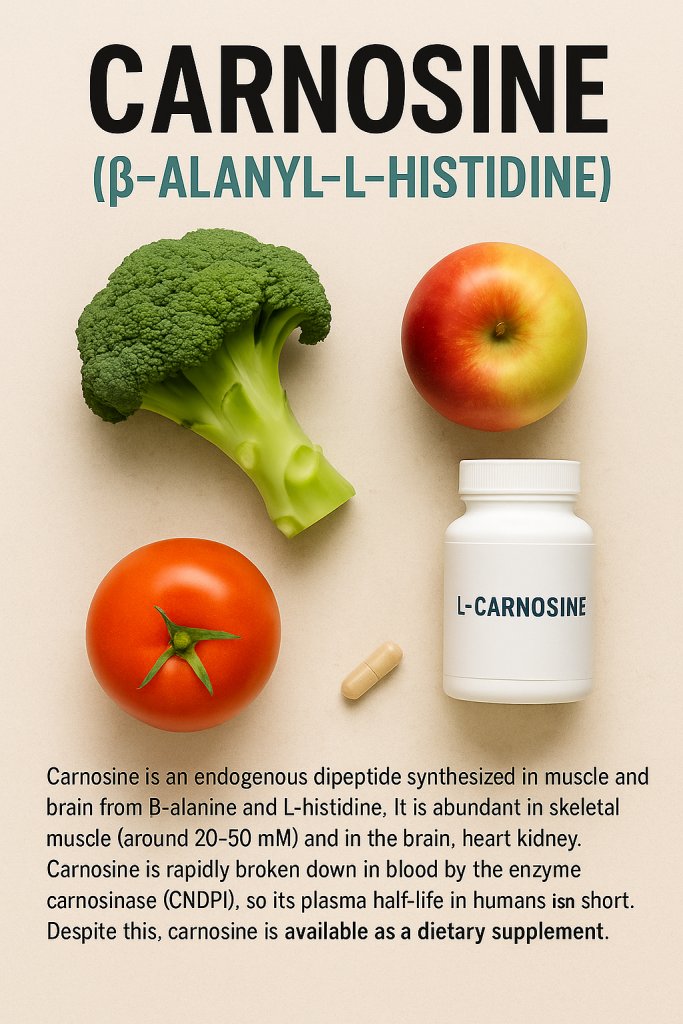
Carnosine and a related dipeptide anserine are found in dietary sources like meat, poultry and fish; many vegetarians have low tissue carnosine. Athletic supplements often provide β-alanine (to boost muscle carnosine), but here we focus on oral carnosine itself. Commercial formulations include simple capsules or tablets of L-carnosine powder, and more advanced forms like granular or coated preparations. For example, Bispit offers granular-coated L-carnosine: microgranules of carnosine with a protective coating (aimed at stability/controlled-release). Such coatings are intended to preserve the dipeptide during digestion and may improve absorption. Bispit’s granular-coated carnosine comes in tablet form, delivering a high-purity L-carnosine dose with no added zinc or other actives. In the sections below we summarize how carnosine’s properties may intersect with gout biology.
Antioxidant and Anti-Inflammatory Properties
A key rationale for carnosine in gout is its antioxidant and anti-inflammatory effects. Gout flares are driven by inflammation: monosodium urate crystals trigger innate immunity and the NLRP3 inflammasome in macrophages, leading to IL-1β release and joint swelling. Carnosine has been shown in many studies to quench free radicals, reduce protein carbonylation, and blunt inflammatory signalingmdpi.commdpi.com. For example, a recent position paper notes that carnosine “detoxifies reactive oxygen and nitrogen species” and “down-regulates pro-inflammatory mediators”mdpi.com. It also inhibits the NLRP3 inflammasome pathway in neural and kidney cells, and blocks NF-κB and JNK signaling, which are common routes of inflammationcolab.wsmdpi.com. In rodent models, carnosine supplementation has consistently reduced oxidative stress markers and inflammatory injury in tissues.
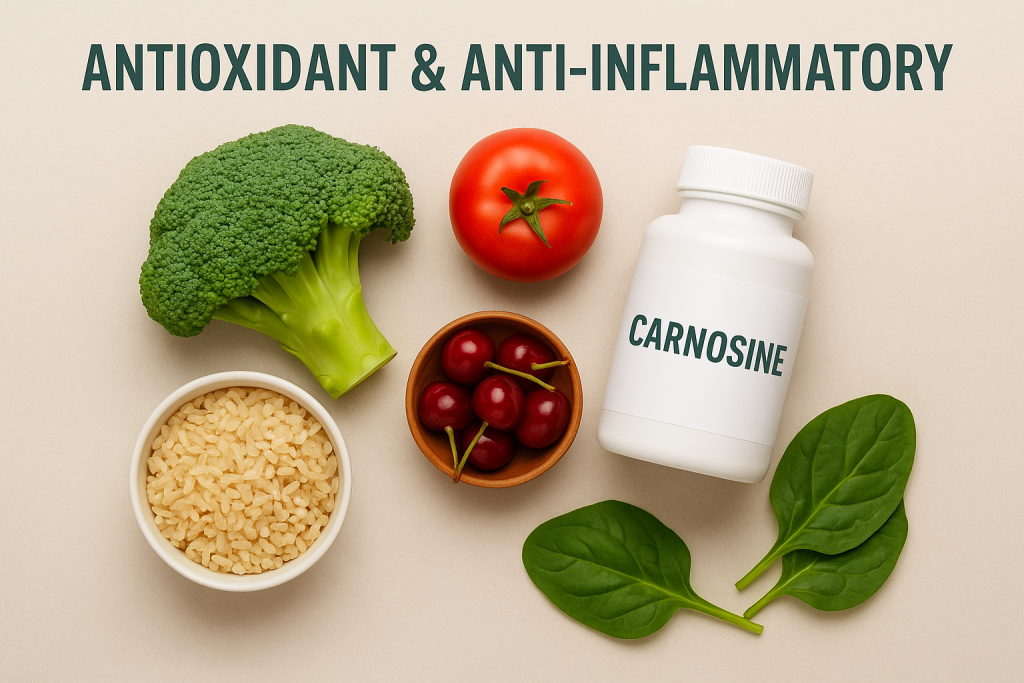
In one rat study of urate kidney stones (urate nephrolithiasis), carnosine (15 mg/kg) produced dramatic antioxidant benefits: lipid peroxidation (measured by TBA-reactive substances) fell by ~40% and total antioxidant capacity rose by ~40%. The liver and kidney antioxidant enzymes (like catalase) were significantly boosted. Importantly, carnosine-treated rats had 60% fewer urate deposits in the kidneys and much milder tissue inflammation than controlspubmed.ncbi.nlm.nih.gov. The authors concluded that carnosine’s “antioxidant, peptide” action effectively attenuated oxidative injury and inflammation in uric acid nephropathypubmed.ncbi.nlm.nih.gov. This suggests carnosine can protect renal tissue from the oxidative damage typically seen in hyperuricemia.
More generally, carnosine’s effects go beyond gout models. A 2022 review of carnosine’s therapeutic potential highlights its broad antioxidant, anti-inflammatory and anti-glycating profilemdpi.com. Human and animal studies link carnosine to reduced inflammatory markers in diabetes, neurodegenerative and vascular diseases. For example, in diabetic rodents carnosine improves kidney histology and lowers inflammatory cytokinespubmed.ncbi.nlm.nih.gov. Thus, from a biological standpoint, carnosine can be seen as a natural anti-inflammatory/antioxidant agent that might dampen the inflammatory cascade triggered by urate crystals. In gout, inhibiting pathways like NF-κB, JNK or NLRP3 could theoretically reduce flare severity. While clinical data in gout are limited, the biochemical mechanism is plausible.
Effects on Uric Acid Metabolism and Excretion
Beyond inflammation, some evidence suggests carnosine may influence uric acid handling in the body. Uric acid levels depend on liver production (via xanthine oxidase) and renal excretion/reabsorption (via transporters like URAT1 and GLUT9). Carnosine’s role in these processes is still being elucidated. Notably, the 2023 rat study of hyperuricemia found that carnosine down-regulated key renal urate transporters. In hyperuricemic rats, one month of carnosine lowered blood uric acid by ~40%colab.ws. Molecular analysis showed that carnosine dramatically suppressed the gene and protein expression of URAT1 and GLUT9, the two main transporters that reabsorb urate from kidney tubules back into bloodcolab.ws. Blocking these transporters would let more uric acid be excreted in urine, explaining the fall in serum levels. The study also showed that inhibiting upstream inflammatory kinases (p65/NF-κB and JNK) achieved the same reduction in URAT1/GLUT9, indicating carnosine acts via those anti-inflammatory routescolab.ws. In summary, carnosine appears to enhance uric acid excretion by suppressing the kidney’s reabsorption mechanisms.
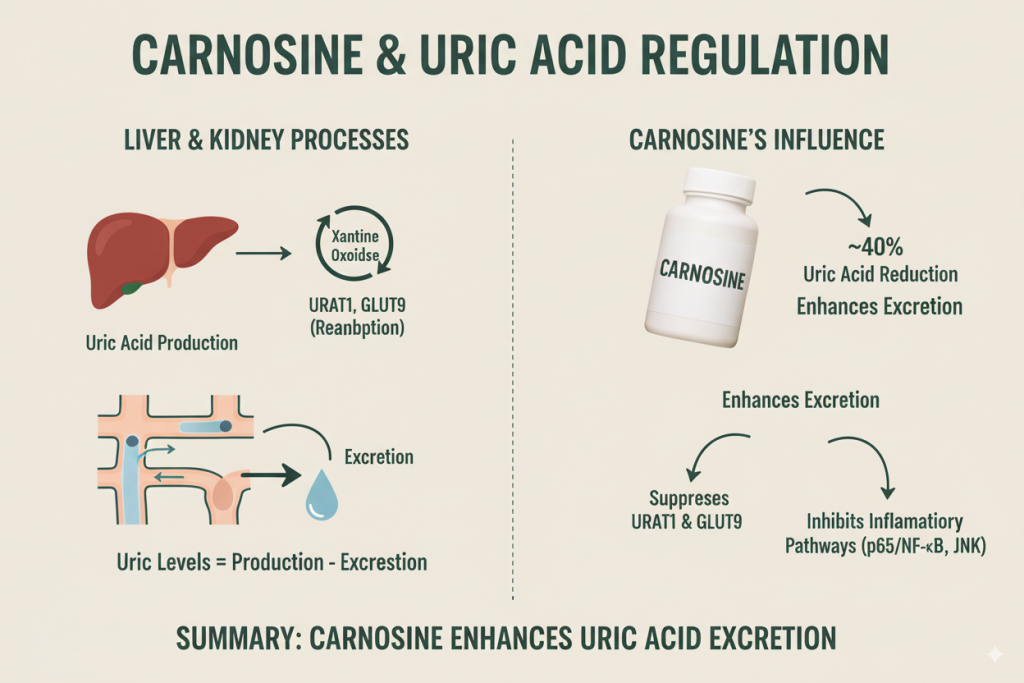
Some of this effect may also relate to metabolic enzyme activity. A hypothesis from clinical researchers is that carnosine (an imidazole dipeptide) can alter cellular pH and enzyme function involved in glycolysis/gluconeogenesis, indirectly reducing urate reabsorption in the kidneypubs.sciepub.com. Whether this is a major mechanism is not fully proven, but it adds plausibility.
Importantly, human data on carnosine lowering uric acid are sparse but suggestive. In one pilot trial, healthy men with borderline-high uric acid took a carnosine-rich supplement for 4 weeks. The supplement (at two dose levels) significantly reduced serum uric acid compared to baselinepubs.sciepub.com. This small study did not isolate carnosine alone (the formulation contained L-carnosine), but it indicates that carnosine-containing foods or supplements can exert a mild hypouricemic effect. Similarly, a randomized trial of a tuna extract (rich in the imidazole peptides carnosine and anserine) showed a modest but significant drop in uric acid in healthy subjectsspandidos-publications.com. In that study, high-dose tuna extract reduced uric acid by about 0.41 mg/dL more than placebo over 4 weeksspandidos-publications.com.
Taken together, these findings raise the possibility that carnosine helps balance uric acid levels through renal effects. The evidence comes mostly from animals, but it dovetails with the notion that carnosine can modulate metabolic enzymes and transporters. For gout patients, this could mean that carnosine supplementation might mildly aid uric acid control in addition to its anti-inflammatory action.
Protection of Kidney and Joint Tissues
Healthy kidney function is vital for excreting uric acid. Any agent that improves kidney health may indirectly protect against gout progression. Carnosine has been shown in multiple models to preserve kidney tissue and function under stress. In the hyperuricemia rat study, markers of renal oxidative damage and inflammation were markedly reduced by carnosinecolab.ws. Carnosine-fed rats had near-normal levels of renal antioxidant enzymes and far fewer signs of tubular injury than untreated rats, suggesting repair of “hepatorenal dysfunction”colab.ws. The urate crystal burden in their kidneys was also lower.
In a broader context, carnosine is known to protect against a variety of nephrotoxic insults. For example, in diabetic nephropathy models carnosine reduces tubulointerstitial fibrosis, lowers inflammatory cytokines (like TGF-β), and improves glomerular functionpubmed.ncbi.nlm.nih.gov. Although gout-specific data are lacking, one can infer that carnosine’s kidney-protective effects could help maintain the organ’s ability to clear uric acid. This is important because kidney disease itself is a risk factor for persistent hyperuricemia and gout. Thus carnosine might act on two fronts: directly suppressing gouty inflammation and helping kidneys handle uric acid more effectively.
Research Evidence: Animal and Human Studies
Most direct evidence on carnosine and gout/hyperuricemia comes from preclinical studies. We summarize key findings below:
- Hyperuricemia rat models: In addition to the study cited abovecolab.ws, earlier rodent experiments found that giving carnosine to hyperuricemic rats improved liver and kidney markers. For example, carnosine-treated rats showed significantly less oxidative stress in liver and kidney, plus lower serum creatinine and uric acidcolab.ws. These improvements correlated with reduced inflammation on tissue microscopy. In every case, carnosine appeared to repair organ damage caused by high uric acid. (These effects are consistent with other research showing carnosine ameliorates chemically-induced liver injury and nephrotoxicity.)
- Urate nephrolithiasis model: The 2021 studypubmed.ncbi.nlm.nih.gov modelled gout-like kidney stone formation and showed that carnosine markedly limited stone formation. The number of kidney urate deposits was 60% lower with carnosine treatment, and all measures of oxidative injury were improvedpubmed.ncbi.nlm.nih.gov. This indicates a strong “anti-crystal” potential in the kidneys, likely by reducing ROS and local inflammation around crystals.
- Cell-based studies: In cultured human kidney cells (HK-2 line), carnosine inhibited several inflammatory signaling proteins (phospho-p65, phospho-JNK, NLRP3, caspase-1) that are also active in gouty inflammationcolab.ws. By downregulating these pathways, carnosine likely prevents cell damage from urate or other stressors. It also decreased URAT1/GLUT9 protein levels in these cells, mirroring the in vivo rat datacolab.ws.
- Human studies: Direct trials of carnosine in gout patients are not available yet. However, as noted, a small human pilot (Derosa et al.) found that an oral supplement containing L-carnosine significantly lowered uric acid and C-reactive protein in people with borderline-high uricemiapubs.sciepub.com. The study enrolled ~100 participants randomized to either the supplement (with carnosine, quercetin, rutin, bromelain) or placebo for 3 months. The active group showed a clear reduction in serum uric acid and inflammatory CRP, whereas placebo did notpubs.sciepub.com. Although this was a multi-ingredient supplement, it indicates that adding carnosine (along with known flavonoids) has measurable effects. Another trial using tuna-derived imidazole peptides (likely carnosine/anserine) also showed a modest urate-lowering effectspandidos-publications.com.
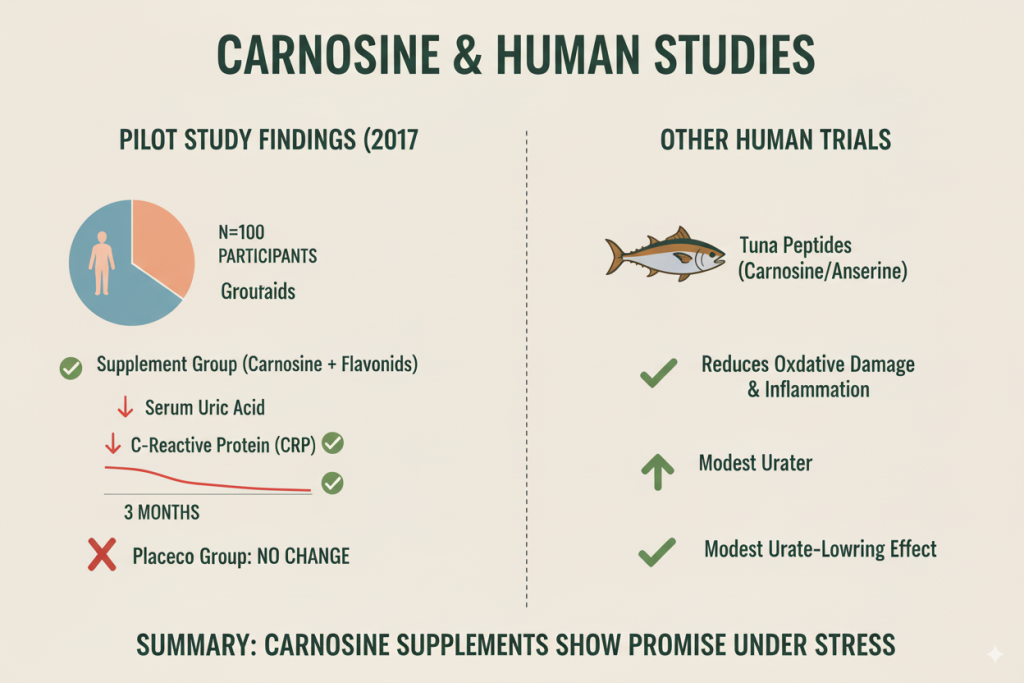
Importantly, none of these studies reported serious side effects from carnosine, and animal models have shown good tolerability. Human safety studies (in diabetes and other conditions) found that carnosine doses up to grams per day produced no significant lab abnormalitiespubs.sciepub.com. Carnosine is naturally metabolized to histidine and β-alanine, both normal amino acids, further suggesting low toxicity.
However, it’s vital to note that evidence gaps remain. No large randomized controlled trials of pure carnosine for gout have been done. Most data come from animal models or combination supplements. The reductions in uric acid seen in human pilots are statistically significant but modest (fractions of a mg/dL)spandidos-publications.compubs.sciepub.com. Gout is a complex disease, and carnosine alone may not be enough to achieve target uric acid in patients with chronic gout. More research, especially clinical trials, is needed to confirm any clinical benefit.
Mechanisms of Action: Key Takeaways
Based on current research, the putative mechanisms by which carnosine may help in gout include:
- Antioxidant scavenging: Directly neutralizing free radicals and reactive carbonyls, protecting tissues (joints, kidneys) from oxidative damagemdpi.compubmed.ncbi.nlm.nih.gov.
- Anti-inflammatory signaling: Inhibiting pathways like NF-κB, JNK and NLRP3 inflammasome, thereby reducing IL-1β and other cytokines that drive gout flarescolab.wsmdpi.com.
- Uric acid transport modulation: Downregulating renal transporters URAT1 and GLUT9, which decreases urate reabsorption and increases urinary excretion of uric acidcolab.wspubs.sciepub.com.
- Enhancing renal function: Protecting kidney cells from urate-induced injury and improving renal antioxidant status, which helps maintain uric acid clearancepubmed.ncbi.nlm.nih.govpubmed.ncbi.nlm.nih.gov.
- pH/enzymatic effects: Possibly buffering cellular pH and affecting metabolic enzymes (glycolysis/gluconeogenesis), which may indirectly influence urate handlingpubs.sciepub.com.
These multiple actions are synergistic: by simultaneously reducing inflammation and boosting uric acid elimination, carnosine could both alleviate acute attacks and lower chronic uric acid burden.
Carnosine Supplementation: Products and Dosage
For patients considering carnosine supplements, several formulations exist. L-carnosine is typically taken orally in pill or capsule form. Doses in studies range widely; animal research often uses equivalent of 100–300 mg/kg (translating to grams per day for humans), but clinical trials often use 1–2 grams per day of L-carnosine. There is no standard prescription dose for gout. Carnosine is available over-the-counter, and is sometimes combined with other antioxidants or minerals (e.g. zinc-carnosine for gut health, though zinc-carnosine is a different compound mainly used for ulcers).
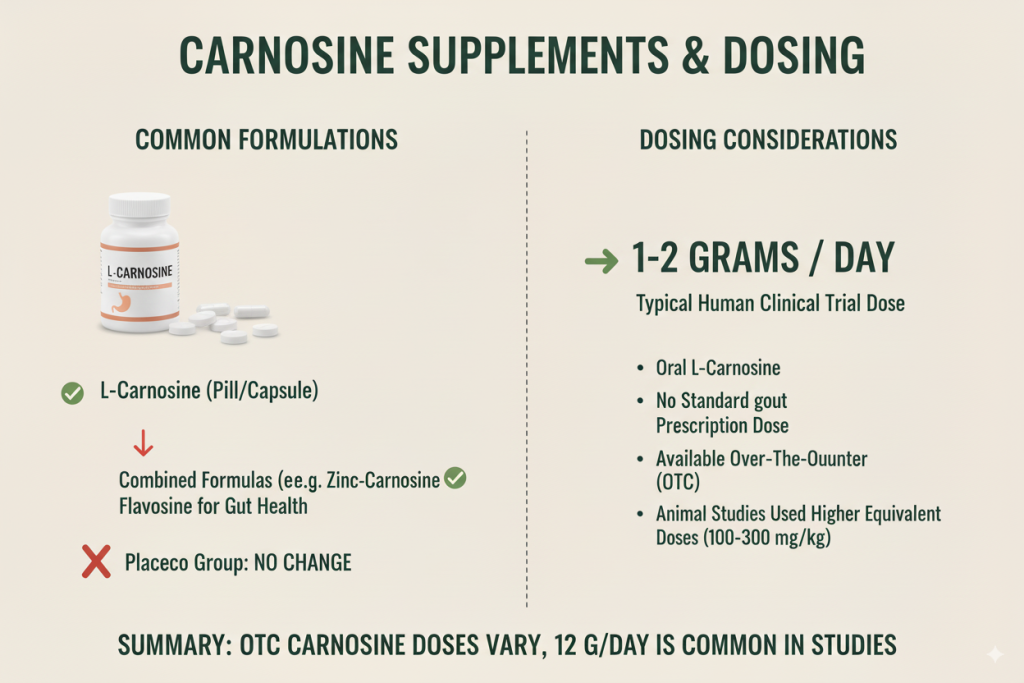
A unique example is Bispit’s Granular-Coated L-Carnosine. This product delivers pure L-carnosine in a microgranule (pelleted) form. The granules are coated, which is intended to improve the stability of the dipeptide and possibly provide a controlled-release effect in the gut. In practice, each tablet contains a precise dose of L-carnosine (e.g. 500 mg) in granular form, which may enhance absorption compared to an uncoated powder. Bispit markets this formulation for antioxidant support and joint health. (Note: Bispit granular-coated carnosine is simply one brand; similar products may be sold under different names by other supplement companies.)
Patients should follow label instructions and consult a physician for dosing. Since human studies on carnosine in gout are limited, it may be reasonable to use supplement doses similar to trials (around 500 mg–1 g twice daily) and monitor uric acid levels. Carnosine is generally well-tolerated, but possible side effects are rare and may include mild gastrointestinal upset. Because carnosine breaks down into histidine and β-alanine, people with histidine metabolism disorders or taking antihistamine drugs should be cautious. No major interactions are known, but as with any supplement, it’s wise to discuss with a healthcare provider, especially if on uric acid–lowering medications.
Safety and Precautions
Carnosine’s safety profile appears favorable. In both animal studies and limited human trials, no significant toxicity or adverse lab changes were reportedpubs.sciepub.com. Human volunteers have taken carnosine for weeks without issues. However, one consideration is that human plasma carnosinase (CNDP1) quickly degrades circulating carnosine. This means much of an oral dose may be broken down before reaching tissues. Some people have genetic differences in carnosinase activity; one review of diabetic nephropathy notes that a common CNDP1 polymorphism (which lowers carnosinase) is associated with slower kidney disease progressionpubmed.ncbi.nlm.nih.gov. This suggests individuals who naturally preserve carnosine better may experience more benefit.
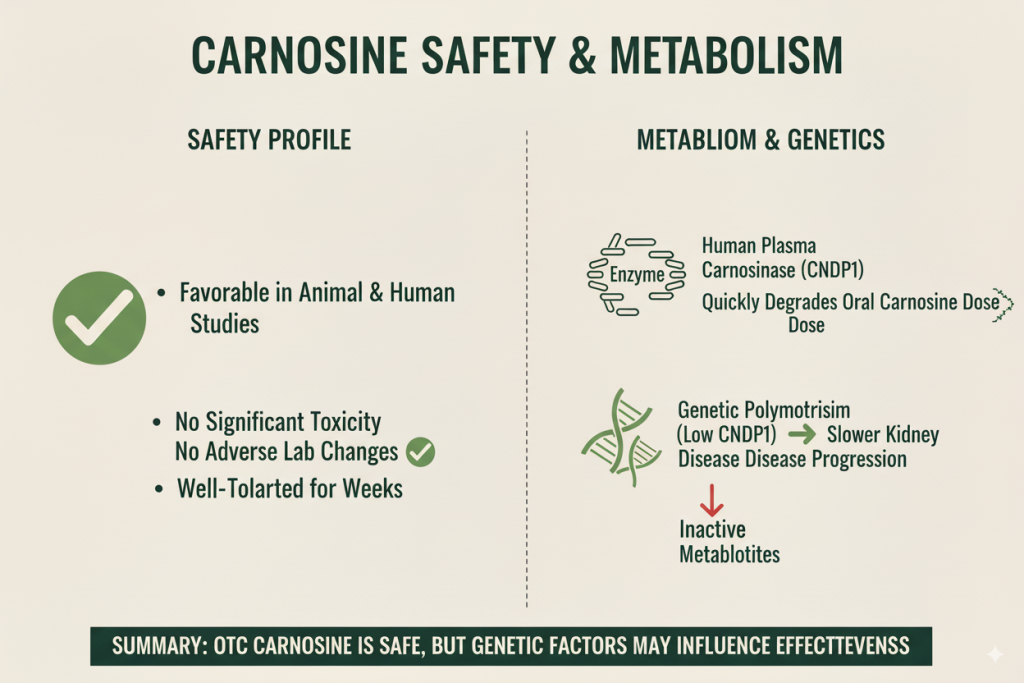
Because carnosine can influence metabolic pathways, it’s theoretically possible it could affect blood pressure or glucose, but no consistent effects have been seen. Long-term data are lacking, so chronic safety is not fully established. Importantly, carnosine supplements should not replace conventional gout treatments. They are adjuncts, not cures. Patients should continue all prescribed gout medications (like allopurinol or colchicine) and lifestyle measures (diet, hydration, weight control). If carnosine is started, it should be part of a comprehensive plan under medical supervision.
Practical Takeaways for Gout Patients
For gout patients interested in carnosine, here are some key points:
- Complementary role: Carnosine is an adjunct, not a standalone treatment. It may help support uric acid management and reduce inflammation, but it should be used in addition to standard therapies (diet change, medications).
- Dietary sources: Carnosine is found in meat and fish, so lean proteins contribute some. Vegetarians are relatively low in carnosine. Supplements offer a way to boost levels without high purine intake.
- Lifestyle synergy: Carnosine’s antioxidant support complements lifestyle measures. Drinking plenty of water, limiting alcohol and sugary drinks, and eating more vegetables and cherries remain primary strategiesbispit.comspandidos-publications.com. Carnosine won’t counteract a very high-purine diet.
- Monitoring response: If you start a carnosine supplement, track your blood uric acid and gout symptoms over months. Any reduction in flare frequency or uric acid should be attributed to the whole plan (diet, drugs, supplement). Small drops in uric acid (fractions of a mg/dL) have been reported with carnosinespandidos-publications.compubs.sciepub.com, which may or may not translate to fewer attacks. Use regular lab tests to check levels.
- Supplement quality: Use a reputable brand. Bispit’s granular-coated L-carnosine is one example of a high-quality supplement. The “granular-coated” formulation is meant to enhance stability. Always look for pure L-carnosine (without excessive additives) and verify the dosage per pill. Third-party testing (e.g. USP, NSF) is a plus for purity.
- Consult healthcare provider: Discuss with your doctor before starting carnosine, especially if you have kidney disease or are on other supplements. Carnosine can slightly raise histidine levels, so inform your doctor of all supplements you take.
Conclusion
In summary, carnosine is a promising nutraceutical with multiple actions that could theoretically benefit gout patients. Its antioxidant and anti-inflammatory effects can protect against the oxidative damage and cytokine-driven inflammation that occur in gout flaresmdpi.compubmed.ncbi.nlm.nih.gov. Recent research also shows carnosine lowers serum uric acid in animal models by inhibiting renal urate transporters and improving kidney functioncolab.wspubs.sciepub.com. Early human trials (using carnosine-containing supplements) report modest urate-lowering and CRP-lowering effectsspandidos-publications.compubs.sciepub.com. Although more clinical studies are needed, these findings suggest carnosine may support long-term gout management.
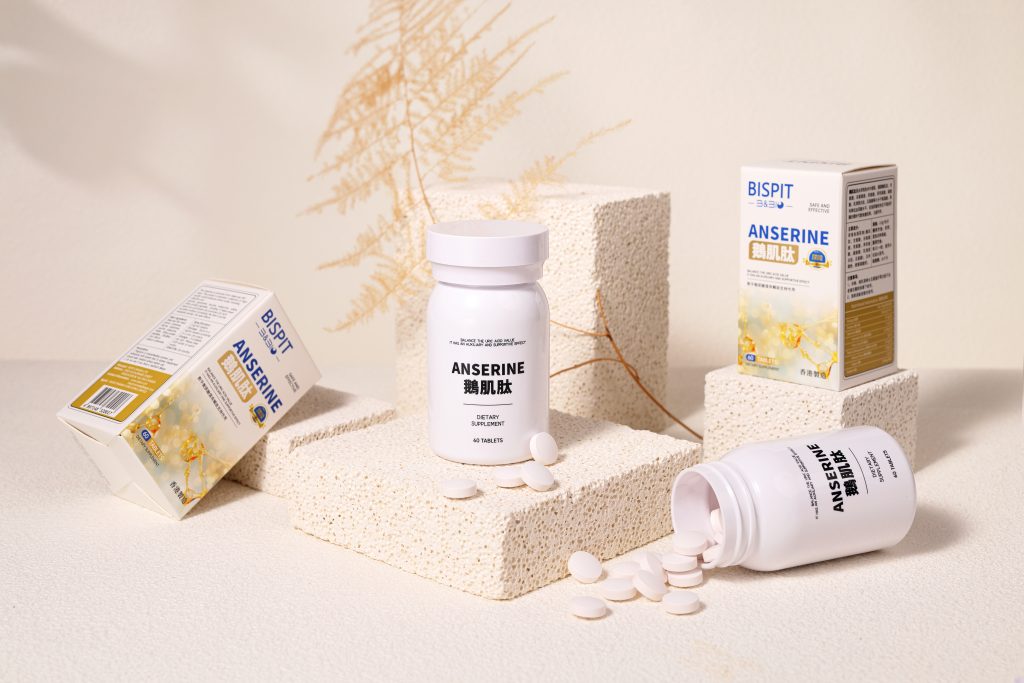
Patients should view carnosine as a complementary strategy: it may help keep uric acid and inflammation in check alongside prescribed medications and lifestyle measures. Supplements like Bispit granular-coated L-carnosine offer a convenient way to take carnosine daily, with a formulation designed for stability and absorption. As always, maintain regular monitoring (e.g. blood uric acid tests) and discuss any new supplements with your healthcare team. Combined with diet changes (hydration, low-purine diet), carnosine supplementation might help reduce the frequency or severity of gout attacks over time.
References: Research on carnosine’s effects in hyperuricemia and gout modelscolab.wspubmed.ncbi.nlm.nih.gov, as well as small human trialsspandidos-publications.compubs.sciepub.com and reviewsmdpi.compubmed.ncbi.nlm.nih.gov, provide the basis for the above discussion. We have also drawn on expert summaries of gout pathophysiology for contextmy.clevelandclinic.orgmy.clevelandclinic.org. All citations are given in the text above.
